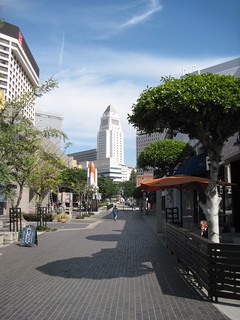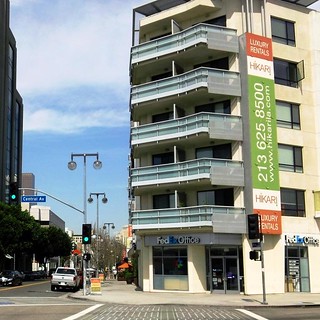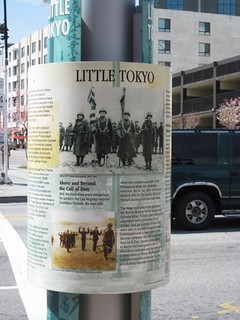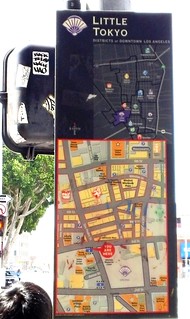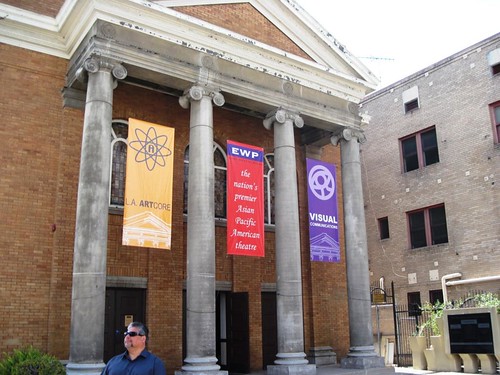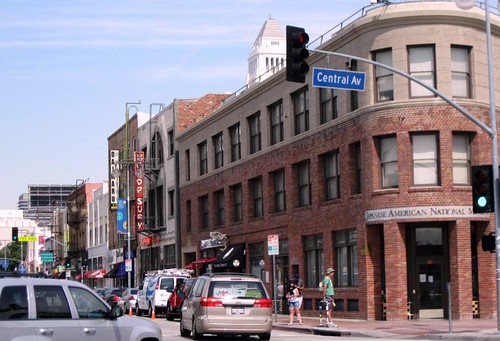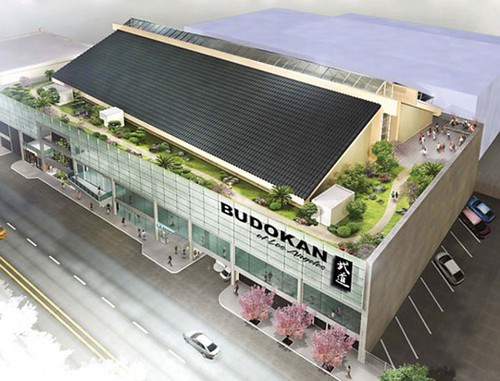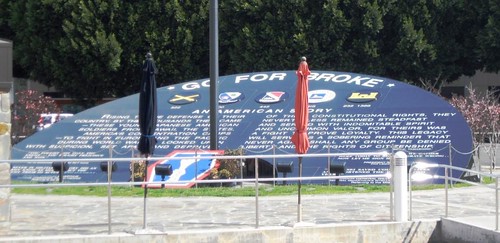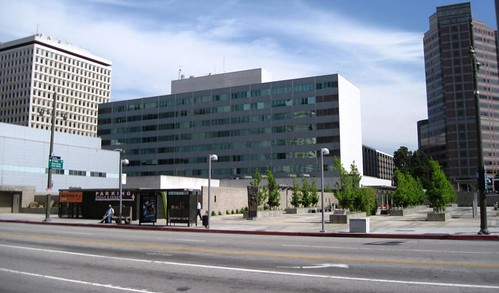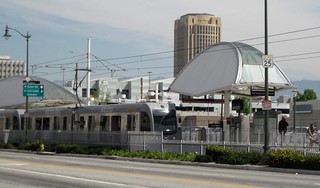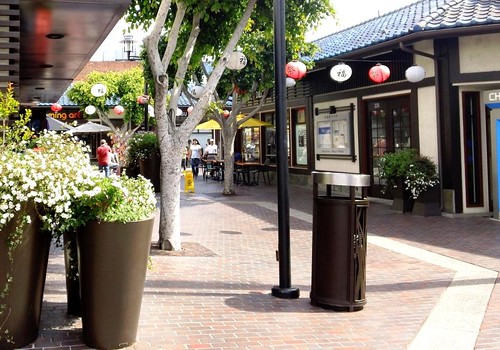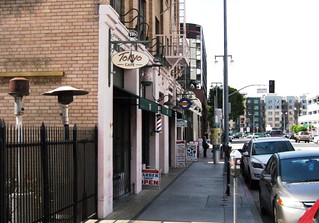Preserving a sense of place in LA's Little Tokyo

Posted April 9, 2012 at 1:27PM
Little Tokyo, an important historic neighborhood of roughly five large city blocks, sits in the heart of downtown Los Angeles, a short walk from the city’s Civic Center. LA’s iconic City Hall is easily visible from all over the district. The neighborhood is the symbolic focal point of Japanese American culture in southern California, housing some 30,000 Japanese Americans at its peak; unfortunately, the number is far smaller today.
Change in Little Tokyo
Little Tokyo is undergoing change, in part because of the proximity of the Civic Center and downtown, and in part because of a busy light rail station that opened in the neighborhood in 2009 and that is attracting development. Potentially, the station could become one of the city’s busiest, because of a project called the Regional Connecter, an extension of nearby transit lines that will transform the Little Tokyo station into a major transfer center. Planned by the Los Angeles County MTA with dedicated funding from a ballot initiative, the Connector is currently undergoing review.
Change can be good, especially if it brings vitality, and the neighborhood would benefit from additional housing. But the question is how Little Tokyo can maintain and strengthen its important cultural identity as new development occurs. As Valentina Cardenas and Gayle Pollard-Terry wrote several years ago in the Los Angeles Times, “the newcomers reflect the region's diversity, but the neighborhood's importance to the Japanese community shouldn't be underestimated.”
The Little Tokyo Service Center
Last week, two NRDC colleagues and I, along with two representatives from the LA office of the Local Initiatives Support Corporation, spent a highly educational day walking and learning about the neighborhood as guests of the impressive Little Tokyo Service Center. LTSC is a nonprofit community development corporation that for some 30 years has built affordable housing, sponsored culturally significant commercial and civic development, and guided a range of social services to the Japanese American community in southern California.
Here’s a brief summary from the organization’s website:
“[The Little Tokyo Service Center Community Development Corporation] sponsors over a dozen different community and social service programs, with over 100 paid staff persons and hundreds of volunteers to provide competent and compassionate services in at least seven different languages as well as Spanish and English. Services include individual and family counseling, support groups, transportation and translation services, an emergency caregiver program, student help lines, crisis hotlines, and consumer education.
“LTSC CDC is also the sponsor of several major community development projects in the Los Angeles area. We have completed over 300 apartments, over 100,000 square feet of community space (such as childcare centers), and have developed over $100 million in community-serving nonprofit real estate projects.”
These are among the bricks-and-mortar projects sponsored by the Service Center:
- Casa Heiwa (Spanish and Japanese for 'House of Harmony'), an award-winning, 100-unit affordable housing complex located in Little Tokyo that also houses LTSC’s offices
- The nearby San Pedro Firm Building, with four commercial storefronts on the ground floor and 42 units of affordable housing on the top floors
- The Union Center for the Arts, a former Japanese American Church that has been renovated to house three arts organizations (photo above)
- The Far East Building, “a historic, mixed-use building with a cafe and computer learning center on the ground floor and 16 units of affordable housing, including 8 units of permanent supportive housing that house formerly homeless individuals”
- A 24-bed transitional shelter for homeless survivors of domestic violence
Read about more of the organization’s development projects here.
An exciting new project is the LTSC-sponsored Budokan of Los Angeles, a major sports complex being built in Little Tokyo to house a four-court gymnasium, additional community space, and a rooftop garden with a jogging track. Called one of “six projects that will shape downtown’s districts in 2012” by the LA Downtown News, the Budokan (named for a style of martial arts and an arena in Tokyo, Japan) will feature “basketball, volleyball, martial arts, special events, tournaments, and programming for all ages.” LTSC is currently raising funds for the project, which two weeks ago was awarded a five million dollar grant from the California Department of Parks and Recreation.
A neighborhood of assets and opportunity
Walking around Little Tokyo, I was struck by the work that the Service Center has done and by the sense of history and culture in the neighborhood. There is a particularly moving monument (see photo and caption below) to the over 15,000 Japanese Americans who served in the US military during World War Two, at a time when their friends and families were forcibly relocated to what were basically the American equivalent of concentration camps. The effect of the internment on Little Tokyo was significant, as many of its residents were forced out of the neighborhood; only a few returned.
AN AMERICAN STORY: "Rising to the defense of their country by the thousands they came - these young Japanese American soldiers from Hawaii, the states, America's concentration camps - to fight in Europe and the Pacific during World War Two. Looked upon with suspicion, set apart and deprived of their constitutional rights, they nevertheless remained steadfast and served with indomitable spirit and uncommon valor, for theirs was a fight to prove loyalty. This legacy will serve as a sobering reminder that never again shall any group be denied liberty and the rights of citizenship."
Other notable cultural elements in the neighborhood include the Aratani Japan America Theatre, the Japanese American Cultural and Community Center, the Japanese American National Museum, and the Geffen Contemporary, a branch of LA’s Museum of Contemporary Art housed in MOCA’s original building (“the temporary contemporary” housed the entire institution while its permanent home was being constructed in the early 1980s). Japanese American small businesses continue to line the streets where historic architecture has been preserved.
At the same time, the challenges to Little Tokyo are plainly visible, as some nearby architecture (particularly a building owned by the police department, and another housing the city’s department of transportation) clashes with the neighborhood’s historic character. Some mid-rise, upscale condo buildings have come in as well; these are architecturally appealing and appropriately scaled but raise the question of maintaining affordability in the district. The light rail station, whose function is a great asset to the neighborhood, contributes nothing to its aesthetics or character, and that’s putting it kindly. Several large surface parking lots in Little Tokyo are ripe for redevelopment, suggesting that there is both challenge and opportunity to strengthen the neighborhood’s historic and cultural identity.
Looking to the future
One senses that the next two decades in particular will be critical to the neighborhood’s legacy. Today, Little Tokyo’s physical identity seems a bit fragmented, in need of additional coherence, though at least some of the newer architecture is helping.
Can the neighborhood become great again while strengthening its traditional function and character as the heart of the Japanese American community in southern California? The presence and work of a highly professional and dedicated organization such as Little Tokyo Service Center certainly gives one hope. From their website:
“The major long-term vision for LTSC CDC is to work with other stakeholders to revitalize Little Tokyo into a vibrant community by addressing cultural and community survival, empowering residents, and promoting the economic health of the area. The Community Organizing department works with the seniors in the affordable housing in the area to insure their voices are heard in the community planning and advocacy process. We also work to create a holistic balance of work, play, and housing by participating in all community planning efforts, particularly those that involve public agencies and community representative bodies, to both inform and advocate on neighborhood issues.”
The neighborhood also is served by a Little Tokyo Senior Residents Association, a Little Tokyo Community Council, a Little Tokyo Business Association, and the Little Tokyo Business Improvement District. My colleagues and I will be rooting for the neighborhood and, to the extent we are able, supporting the community’s efforts.
“The environment” is more than air, water, and ecosystems
Indeed, cultural and historic preservation are dear to my heart. I’ve written before about efforts to strengthen a Birmingham, Alabama neighborhood that played a seminal role in the American civil rights movement; the wonderful Watts Housing Project, using art to strengthen a distressed neighborhood in the shadow of LA’s iconic Watts Towers; a local neighborhood council creating a lively, diverse identity for East Hollywood; and (just last week) about culturally sensitive housing for Native Americans. Centrally located, transit-served historic neighborhoods such as Little Tokyo are in a sense inherently green compared to most of America, but only if the full context surrounding historic properties is strong.
This leads to a more philosophical point, and an important one. The organization I work for is called the Natural Resources Defense Council for a reason: NRDC will always be true to our name and vigorously support clean and healthy air, water, and ecosystems. But our pledge to foster sustainable communities does not and cannot end there. Sustainability involves the built, social, and cultural environment as well – the human aspects of community – and special places like Little Tokyo are environmental resources every bit as important as those put in place by nature. They, too, deserve our very best stewardship.
Related posts:
- The importance of legacy to sustainability (November 28, 2011)
- Will this historic downtown recover? (photoessay) (May 6, 2011)
- LA mayor’s bold plan for affordable, sustainable housing (October 20, 2008)
Move your cursor over the images for credit information.
Please also visit NRDC’s Sustainable Communities Video Channel.

